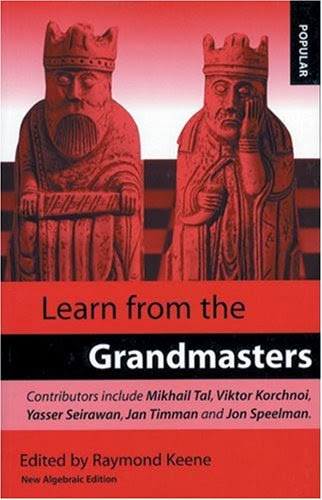You may have seen this recent addition to Edward Winter's article Copying. The article explains its provenance.
Amusing and ironic, you may have thought, that there should be legal threats concerning plagiarism on behalf of the newspaper which employs and protects Britian's most notorious plagiarist. But it is more amusing and ironic than you may have realised, since among the many people who Ray has plagiarised we can include Bill Hartston, the recipient of those very legal threats.
This particular act of plagiarism wasn't, however, carried out in the Times. Here is Ray's Spectator column for 14 April 2012, in which he annotated the game Hartston-Westerinen, Alicante 1973.
I say "annotated", but what I really mean is "purported to annotate", since the notes are actually Bill Hartston's, written for Learn from the Grandmasters, the same book which we featured a fortnight ago. Edited by Ray, this book was published by Batsford in 1975 and we display below the cover of the second edition, published in 1998.
Hartston annotates the game on pages 78 to 81 of Learn From The Grandmasters (in the second edition, at any rate). Although Ray edited the volume, the annotations (with the exception of one chapter which he himself contributed) are not his: the scheme is explained in his introduction.
As you can see, the annotations that appear in the Spectator are very, very close indeed to the originals.
1. Black's move six.
Spectator:
Learn from the Grandmasters:
Ray reproduces Hartston's note word-for-word, with the exception of dropping the word "really". This is one change more than he makes for the next three notes.
2. Black's move eight.
Spectator:
Learn from the Grandmasters:
3. White's move eleven.
Spectator:
Learn from the Grandmasters:
4. Black's move twelve.
Spectator:
Learn from the Grandmasters:
5. White's move fifteen.
Spectator:
Learn from the Grandmasters:
This time Ray cuts out a whole sentence, albeit the rest of the stolen goods are displayed exactly as the original owner displayed them.
The next note, though, presents us with a puzzle.
6. Black's move sixteen.
Spectator:
Learn from the Grandmasters:
Quotation marks. Moreover, it's clear from the context that it can only be Hartston who is being quoted. But Ray doesn't actually say so, still less say where the quote comes from. Moreover, we have three notes above which are quotes every bit as much as this one is.
So what's that about? I have a theory, but we'll get back to it after the last three notes - all of which are, too, taken word-for-word from Hartston. And not a quotation mark in sight.
7. White's move nineteen.
Spectator:
Learn from the Grandmasters:
8. White's move twenty-two.
Spectator:
Learn from the Grandmasters:
9. Black's move twenty-five.
Spectator:
Learn from the Grandmasters:
Fantastic stuff. As crude and blatant an act of plagiarism as Ray has ever carried out.
With the exception, that is, of that one mysterious note.
Why did Ray do this? It wasn't, clearly, to attribute the notes to the person who actually wrote them. Had he wanted to do that he could have done so without difficulty ("notes by Bill Hartston" - how hard is that?) but he chose not to. There is, as I said above, no mention that Hartston wrote the notes, nor is there any mention, in the column, of the book in which he wrote them - not in the notes, nor in the introduction.
In truth, if you think about it, the inclusion of the quotation marks serves to give the impression that the rest is all original. After all, why give quotation marks in one place but not others?
That's not to say that among the intentions isn't to give some slight semblance of acknowledgement. Indeed I'm sure that's precisely why the quotation marks are there, a microscopic fig-leaf in the classic Ray style, albeit their presence is entirely inadequate in rendering the piece anything other than a grotesque act of plagiarism.
Extraordinary even by Ray's standards, this one. And perhaps even more extraordinary because it wasn't Ray's first bite at this particular cherry. But more on that later in the week.
[Thanks to Pablo Byrne and John Cox]
[Ray Keene plagiarism index]
[Plagiarised by Ray Keene index]
[Ray Keene index]
.GIF)
acknowledgement.GIF)
























5 comments:
I wouldn't exclude the possibility that the quotation marks were inserted by a subeditor on the Spectator. If I were in that situation, checking through a long-standing columnist's copy, I'd be inclined to suspect he'd simply made a typographical slip.
I own a Hartston book about one of the Karpov-Korchnoi matches, and I am sure it has the same paragraph at the beginning!
I wouldn't exclude the possibility that the quotation marks were inserted by a subeditor on the Spectator.
Maybe, but they'd surely have had to insert a lot more quotation marks bearing in mind how much was borrowed. I'm assuming they're Ray's: and there'll be more on this on Friday.
Maybe, but they'd surely have had to insert a lot more quotation marks bearing in mind how much was borrowed. I'm assuming they're Ray's: and there'll be more on this on Friday.
Yes although whilst the rest of it could have been Ray, in this bit it's obviously in the wrong voice (it couldn't be Ray's opponent).
It's maybe possible that Ray missed this and an editor picked it up?
Possibly, but I think Ray's quite capable of changing the voice when he needs to. I think it's deliberately as it is.
Post a Comment